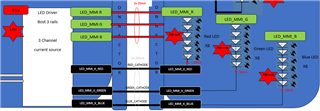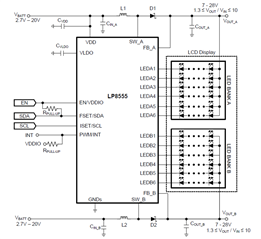Other Parts Discussed in Thread: LP5520, LM3697, LM3532
Dear TI technical support,
I contact you because I'm looking for a specific LED driver.
And after several hours of research, It seems that it is not so easy to find what I'm looking for.
I'm looking for a driver which could be like the one just below (to manage 8 deported RGB LEDs).
The goal is to manage the LED in serial in order to limit the number of contacts between the main board where is located the Driver and the LED board where are located the 8 RGB LEDs.

The technical inputs and requirements are the following :
|
Supplier into the panel |
Number of |
Current source level per channel |
Vin |
Vout variation for 8 serial LEDs according to color rails |
Topology |
Number of integrated boost |
Interface |
Package |
Global |
MOQ |
Lead Time |
Perennity |
Price |
||||||
|
Red |
Green |
Blue |
|||||||||||||||||
|
Min |
Max |
Min |
Max |
Min |
Max |
||||||||||||||
|
Requirements |
Yes |
3 |
20 |
5,25V |
13,6 |
18,4 |
16,8 |
24 |
20 |
25,6 |
Boost |
between 1 to 3 if possible to limit power dissipation |
I2C for 3 channel PWM configuration |
Shall match with our dissipation constraints |
> 80% |
< 1000 |
< 10 |
> 5 |
< 1€ |
The LP8555 is nearly in line with me need but I 'm a little bored to use only 3 currents sources in on 12.
It is not optimized

I have seen an other chip (LP5520) which is more closed to my need in terms of current sources but not in line with :
- the output voltage that is requested in my case (Max 25,6V).
- the power optimisation with different boost output values (nevertheless, I think one common Boost for all RGB colors could be acceptable because I have only 20mA per string).
Could you provide me the most appropriated reference regarding my need?
Thank you for your feedback.
Best regards.
Anthony


